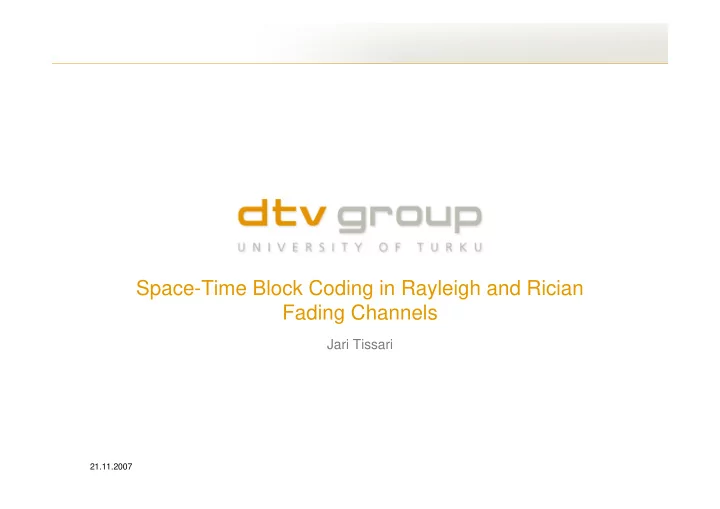

Space-Time Block Coding in Rayleigh and Rician Fading Channels Jari Tissari 21.11.2007
Introduction – space-time coding • Signal propagation in multipath channels causes the received signal power to fade, leading to severe degradation on signal quality • Space-time coding, a combination of channel coding and transmit diversity, can be used to reduce the harmful effect of signal fading • The encoder takes a group of binary information symbols and maps them into modulation symbols • Encoded data is fed to a serial-to-parallel converter and transmitted simultaneously by multiple antennas • Different types of STCs: block and trellis codes, layered space-time codes 21.11.2007 2
Space-time block coding • Space-time block codes are designed to achieve full transmit diversity using an arbitrary number of transmit antennas • The codes are constructed through orthogonal designs • Decoding by maximum likelihood algorithms based only on simple linear processing – no channel state information is required at the transmitter ⎡ ∗ ⎤ − x x = 1 2 • Example: The Alamouti code for two transmit antennas ⎢ ⎥ X ∗ ⎣ ⎦ x x 2 1 Alamouti encoder 21.11.2007 3
Performance simulations • Alamouti code using different numbers of receive antennas • Codes for two, three and four transmit antennas using different spectral efficiencies • The above codes using two-antenna receive diversity • Slow and flat Rayleigh/Rician fading channel • Modulation: BPSK/QPSK/16-QAM 21.11.2007 4
Performance of the Alamouti Code BER performance of BPSK Alamouti scheme on Rayleigh fading channels 0 10 Uncoded n R =1 n R =2 -1 n R =4 10 -2 10 P b -3 10 -4 10 0 5 10 15 20 25 30 35 SNR, dB 21.11.2007 5
Performance of different codes at spectral efficiency 1 bps/Hz BER performance of codes attaining 1 bps/Hz 0 • Alamouti, BPSK: 10 No diversity R=1, m=1 Alamouti • Xc3, QPSK: R=1/2, c X 3 m=2 -1 c X 10 4 • Xc4, QPSK: R=1/2, m=2 η = -2 mR 10 P b -3 10 -4 10 0 5 10 15 20 25 30 35 SNR, dB 21.11.2007 6
Performance of different codes at spectral efficiency 2 bps/Hz BER performance of codes attaining 2 bps/Hz 0 • Alamouti, QPSK: 10 R=1, m=2 No diversity Alamouti • Xc3, 16-QAM: c X R=1/2, m=4 3 c -1 X 10 • Xc4, 16-QAM: 4 R=1/2, m=4 η = mR -2 10 P b -3 10 -4 10 0 5 10 15 20 25 30 35 SNR, dB 21.11.2007 7
Performance of different codes at spectral efficiency 3 bps/Hz BER performance of codes attaining 3 bps/Hz 0 • Alamouti, 8-PSK: 10 R=1, m=3 No diversity Alamouti • Xh3, 16-QAM: h X R=3/4, m=4 3 h -1 X 10 • Xh4, 16-QAM: 4 R=3/4, m=4 η = mR -2 10 P b -3 10 -4 10 0 5 10 15 20 25 30 35 40 SNR, dB 21.11.2007 8
Performance of STBCs using receive diversity BER performances at 1 bps/Hz using two receive antennas 0 • Alamouti, BPSK: 10 R=1, m=1 No diversity Alamouti • Xc3, QPSK: R=1/2, c X m=2 3 c -1 X 10 • Xc4, QPSK: R=1/2, 4 m=2 η = mR -2 10 P b -3 10 -4 10 0 5 10 15 20 25 30 35 SNR, dB 21.11.2007 9
Code performance in Rician fading channels: two transmit antennas BER performance of BPSK Alamouti scheme on Rician fading channels 0 • K=-inf dB: Rayleigh 10 fading channel K=-inf dB K=0 dB • K=20 dB: very strong K=5 dB LOS component K=10 dB -1 10 K=20 dB -2 10 P b -3 10 -4 10 0 2 4 6 8 10 12 14 16 18 20 SNR, dB 21.11.2007 10
Code performance in Rician fading channels: three transmit antennas c on Rician fading channels BER performance of X 3 0 • K=-inf dB: Rayleigh 10 K=-inf dB fading channel K=0 dB • K=20 dB: very strong K=5 dB LOS component K=10 dB -1 10 K=20 dB -2 10 P b -3 10 -4 10 0 2 4 6 8 10 12 14 16 18 20 SNR, dB 21.11.2007 11
Code performance in Rician fading channels: four transmit antennas c on Rician fading channels BER performance of X 4 0 • K=-inf dB: Rayleigh 10 K=-inf dB fading channel K=0 dB • K=20 dB: very strong K=5 dB LOS component K=10 dB -1 K=20 dB 10 -2 10 P b -3 10 -4 10 0 2 4 6 8 10 12 14 16 18 20 SNR, dB 21.11.2007 12
Simulation results / conclusions • Even a basic STBC system offers a significant gain in performance • The codes provide radically improved signal quality even in very harsh propagation conditions • The optimal code depends on the system environment: at low SNRs, using a spectral efficiency >1 bps/Hz, the simplest code (Alamouti with two Tx antennas) is the optimal choice • Using receive diversity results in larger performance gain than using additional transmit antennas • When there is a strong line-of-sight component available, signal fading is negligible and space-time coding will not provide any performance gain 21.11.2007 13
Recommend
More recommend